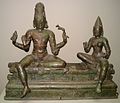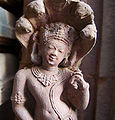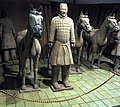Sculpture
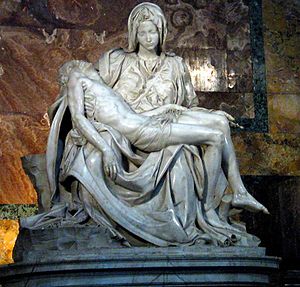

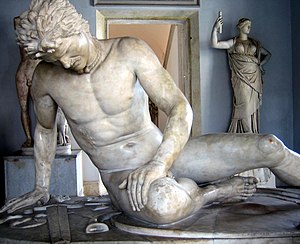
Sculpture is three-dimensional artwork created by shaping hard or plastic material, commonly stone (either rock or marble), metal, or wood. Some sculptures are created directly by carving; others are assembled, built up and fired, welded, molded, or cast. A person who creates sculptures is called a sculptor. Because sculpture involves the use of materials that can be moulded or modulated, it is considered one of the plastic arts. The majority of public art is sculpture. Many sculptures together in a garden setting may be referred to as a sculpture garden.
Types of sculpture
Some common forms of sculpture are:
- Free-standing sculpture, sculpture that is surrounded on all sides, except the base, by space. It is also known as sculpture "in the round," and is meant to be viewed from any angle.
- Jewelery
- Relief - the sculpture is still attached to a background; types are bas-relief, alto-relievo, and sunken-relief
- Site-specific art
- Kinetic sculpture - involves aspects of physical motion
- Statue - representationalist sculpture depicting a specific entity, usually a person, event, animal or object
- Bust - representation of a person from the chest up
- Equestrian sculpture - typically showing a significant person on horseback
- Stacked art - a form of sculpture formed by assembling objects and 'stacking' them
Materials of sculpture through history
Sculptors have generally sought to produce works of art that are as permanent as possible, working in durable and frequently expensive materials such as bronze and stone: marble, limestone, porphyry, and granite. More rarely, precious materials such as gold, silver, jade, and ivory were used for chryselephantine works. More common and less expensive materials were used for sculpture for wider consumption, including hardwoods (such as oak, box/boxwood, and lime/linden); terra cotta and other ceramics, and cast metals such as pewter and zinc (spelter).
Many sculptors seek new ways and materials to make art. Jim Gary used stained glass and automobile parts, tools, machine parts, and hardware. One of Pablo Picasso's most famous sculptures included bicycle parts. Alexander Calder and other modernists made spectacular use of painted steel. Since the 1960s, acrylics and other plastics have been used as well. Andy Goldsworthy makes his unusually ephemeral sculptures from almost entirely natural materials in natural settings. Some sculpture, such as ice sculpture, sand sculpture, and gas sculpture, is deliberately short-lived.
Sculptors often build small preliminary works called maquettes of ephemeral materials such as plaster of Paris, wax, clay, or plasticine, as Alfred Gilbert did for 'Eros' at Piccadilly Circus, London. In Retroarchaeology, these materials are generally the end product.
Asian
Many different forms of sculpture were used in Asia, with many pieces being religious art based around Hinduism and Buddhism (Buddhist art). A great deal of Cambodian Hindu sculpture is preserved at Angkor, however organized looting has had a heavy impact on many sites around the country. In Thailand, sculpture was almost exclusively of Buddha images. Many Thai sculptures or temples are gilded, and on occasion enriched with inlays. See also Thai art
South Asia

The first known sculptures are from the Indus Valley civilization (3300–1700 BC), found in sites at Mohenjo-daro and Harappa in modern-day Pakistan. These are among the earliest known instances of sculpture in the world. Later, as Hinduism, Buddhism, and Jainism developed further, India produced bronzes and stone carvings of great intricacy, such as the famous temple carvings which adorn various Hindu, Jain and Buddhist shrines. Some of these, such as the cave temples of Ellora and Ajanta, are examples of Indian rock-cut architecture, perhaps the largest and most ambitious sculptural schemes in the world.
During the 2nd to 1st century BC in northern India, in what is now southern Afghanistan and northern Pakistan, sculptures became more anatomically realistic, often representing episodes of the life and teachings of Gautama Buddha. Although India had a long sculptural tradition and a mastery of rich iconography, the Buddha was never represented in human form before this time, but only through symbols such as the stupa. This alteration in style may have occurred because Gandharan Buddhist sculpture in ancient Afghanistan acquired Greek and Persian influence. Artistically, the Gandharan school of sculpture is characterized by wavy hair, drapery covering both shoulders, shoes and sandals, and acanthus leaf decorations, among other things.
The pink sandstone sculptures of Mathura evolved during the Gupta Empire period (4th-6th century AD) to reach a very high fineness of execution and delicacy in the modeling. Gupta period art would later influence Chinese styles during the Sui dynasty, and the artistic styles across the rest of east Asia. Newer sculptures in Afghanistan, in stucco, schist or clay, display very strong blending of Indian post-Gupta mannerism and Classical influence. The celebrated bronzes of the Chola dynasty (c. 850-1250) from south India are of particular note; the iconic figure of Nataraja being the classic example. The traditions of Indian sculpture continue into the 20th and 21st centuries with for instance, the granite carving of Mahabalipuram derived from the Pallava dynasty. Contemporary Indian sculpture is typically polymorphous but includes celebrated figures such as Dhruva Mistry.
-
Buddhist, 1st-2nd century AD
-
Hindu, Chola period, 1000 AD
-
Buddhist, 2nd century
-
Chola-ra bronze, 11th-12th centuries
-
Hoysala emblem
-
13th century Ganesha
-
Siva and Parvarti
-
Ellora Kailash temple Shiva
-
Bhudevi
-
14th century sculpture
-
In Khajuraho
-
in Ellora cave
-
Sculpture at Parsurameswar Temple, Bhubaneswar
-
Sculpture of Dancing Woman at Parsurameswar Temple
-
Lord Bishnu at Bhubaneswar
-
A Sculpture in Mukteswar temple, Bhubaneswar
China

Artifacts from China date back as early as 10,000 BC and skilled Chinese artisans had been active very early in history, but the bulk of what is displayed as sculpture comes from a few select historical periods. The first period of interest has been the Western Zhou Dynasty (1050-771 BC), from which come a variety of intricate cast bronze vessels. The next period of interest was the Han Dynasty (206 BC-220 AD), beginning with the spectacular Terracotta Army assembled for the tomb of Qin Shi Huang, the first emperor of the important but short-lived Qin Dynasty that preceded the Han. Tombs excavated from the Han period have revealed many figures found to be vigorous, direct, and appealing 2000 years later.
The first Buddhist sculpture is found dating from the Three Kingdoms period (3rd century), while the sculpture of the Longmen Grottoes near Luoyang, Henan Province (Northern Wei, 5th and 6th century) has been widely recognized for its special elegant qualities.
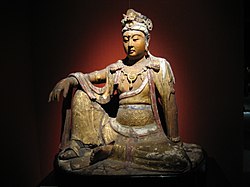
The period now considered to be China's golden age is the Tang Dynasty, coinciding with what in Europe is sometimes called the Dark Ages). Decorative figures like those shown below became very popular in 20th century Euro-American culture, and were made available in bulk, as warlords in the Chinese civil wars exported them to raise cash. Considered especially desirable, and even profound, was the Buddhist sculpture, often monumental, begun in the Sui Dynasty, inspired by the Indian art of the Gupta period, and many are considered treasures of world art.
Following the Tang, Western interest in Chinese artifacts drops off dramatically, except for what might be considered as ornamental furnishings, and especially objects in jade. Pottery from many periods has been collected, and again the Tang period stands out apart for its free, easy feeling. Chinese sculpture has no nudes --other perhaps than figures made for medical training or practice -- and very little portraiture compared with the European tradition. One place where sculptural portraiture was pursued, however, was in the monasteries.
Almost nothing, other than jewelry, jade, or pottery is collected by art museums after the Ming Dynasty ended in the late 17th century -- and absolutely nothing has yet been recognized as sculpture from the tumultuous 20th century, although there was a school of Soviet-influenced social realist sculpture in the early decades of the Communist regime, and as the century turned, Chinese craftsmen began to dominate commercial sculpture genres (the collector plates, figurines, toys, etc) and avant garde Chinese artists began to participate in the Euro-American enterprise of contemporary art.
-
Wine jar, Western Zhou Dynasty (1050 BC-771 BC)
-
Calvalryman, Qin Dynasty
-
Terracotta Army soldier and horse from the Qin Dynasty
-
Chimera (from a tomb) , Han Dynasty (202 BC-220 AD)
-
Tomb figure, Han Dynasty (202 BC-220 AD)
-
Northern Wei Dynasty Maitreya (386-534)
-
Tang Dynasty rider (618-907)
-
Tang Dynasty girl figurine (618-907)
-
Boddisatva, Tang Dynasty (618-907)
-
The Leshan Giant Buddha, Tang Dynasty, completed in 803.
-
Portrait of monk, Song Dynasty, 11th century
-
A wooden Bodhisattva from the Song Dynasty (960-1279)
-
A glazed stoneware statue, Ming Dynasty (16th century)
-
Statue of Guanyin, by Chaozhong He, Ming Dynasty (1368-1644)
-
Blue underglaze statue of a man with his pipe, from Jingdezhen, Ming Dynasty (1368-1644)
-
Doctor's lady, mid-19th century
Japan
Countless paints and sculpture were made, often under governmental sponsorship. Most Japanese sculpture is associated with religion, and the medium' use declined with the lessening importance of traditional Buddhism. During the Kofun period of the third century, clay sculptures called haniwa were erected outside tombs. Inside the Kondo at Hōryū-ji is a Shaka Trinity (623), the historical Buddha flanked by two bodhisattvas and also the Guardian Kings of the Four Directions The wooden image ( 9th c.) of Shakyamuni, the "historic" Buddha, enshrined in a secondary building at the Muro-ji, is typical of the early Heian sculpture, with its ponderous body, covered by thick drapery folds carved in the hompa-shiki (rolling-wave) style, and its austere, withdrawn facial expression. The Kei school of sculptors, particularly Unkei, created a new, more realistic style of sculpture.
Africa

African art has an emphasis on Sculpture - African artists tend to favor three-dimensional artworks over two-dimensional works. Although anthropologists argue that the earliest known sculptures in Africa are from the Nok culture of Nigeria that date around 500 BC, the art of Pharaonic Africa date much earlier than the Nok period. Metal sculptures from the eastern portions of west Africa such as Benin, are considered among the best ever produced.
Art plays an essential role in the lives of the African peoples and communities across the continent. The beauty of African art is simply in meaning. These objects mean a great deal to the people and they are of significant meaning to the traditions that produce them. Their beauty and content protect the community and the individual artists, and tell much of the artists who use them. Later exhibitions of African art in the West have been able to get much detailed catalogues that attempt to cover the art of the whole continent.
African Sculptures
Sculptures are created to symbolize and reflect the regions from which they are made. Right from the materials and techniques used, the pieces have functions that are very different from one region to the other.
In West Africa, the figures have elongated bodies, angular shapes, and facial features that represent an ideal rather than an individual. These figures are used in religious rituals. They are made to have surfaces that are often coated with materials placed on them for ceremonial offerings. In contrast to these sculptures of West Africa are the ones of Mande-speaking peoples of the same region. The Mande pieces are made of wood and have broad, flat surfaces. Their arms and legs are shaped like cylinders.
In Central Africa, however, the key characteristics include heart shaped faces that are curve inward and display patterns of circles and dots. Although some groups prefer more of geometric and angular facial forms, not all pieces are exactly the same. Also, not all pieces are made of the same material. The materials used range from mostly wood all the way to ivory, bone, stone, clay, and metal. Overall, though, the Central African region has very striking styles that is very easy to identify. With the distinctive style, one can easily tell which area the sculpture was produced in.

Eastern Africa is not known for their sculptures but one type that is done in this area is pole sculptures. These are a pole carved in a human shape and decorated with geometric forms, while the tops are carved with figures of animals, people, and various objects. These poles are then placed next to graves and are associated with death and the ancestral world.
Southern Africa’s oldest known clay figures date from 400 to 600 A.D. and have cylindrical heads. These clay figures have a mixture of human and animal features. Other than clay figures, there are also wooden headrests that were buried with their owners. The headrests had styles ranging from geometric shapes to animal figures. Each region had a unique style and meaning to their sculptures. The type of material and purpose for creating sculpture in Africa reflect the region from which the pieces are created.
Egypt
The monumental sculpture of Ancient Egypt is world-famous, but refined and delicate small works are also a feature. The ancient art of Egyptian sculpture evolved to represent the ancient Egyptian gods, and Pharaohs, the divine kings and queens, in physical form. Very strict conventions were followed while crafting statues: male statues were darker than the female ones; in seated statues, hands were required to be placed on knees and specific rules governed appearance of every Egyptian god. Artistic works were ranked according to exact compliance with all the conventions, and the conventions were followed so strictly that over three thousand years, very little changed in the appearance of statues except during a brief period during the rule of Akhenaten and Nefertiti when naturalistic portrayal was encouraged.
The Americas

Sculpture in what is now Latin America developed in two separate and distinct areas, Mesoamerica in the north and Peru in the south. In both areas, sculpture was initially of stone, and later of terra cotta and metal as the civilizations in these areas became more technologically proficient. [1] The Mesoamerican region produced more monumental sculpture, from the massive block-like works of the Olmec and Toltec cultures, to the superb low reliefs that characterize the Mayan and Aztec cultures. In the Andean region, sculptures were typically small, but often show superb skill. In North America, wood was sculpted for totems, totem poles, masks, and boats. The arrival of European Catholic culture readily adapted local skills to the prevailing Baroque style, producing enormously elaborate retablos and other church sculptures in a slightly hybrid style. Later, artists trained in the Western academic tradition followed European styles until in the late nineteenth century they began to draw again on indigenous influences.
The history of sculpture in the United States after Europeans' arrival reflects the country's 18th-century foundation in Roman republican civic values and Protestant Christianity. Compared to areas colonized by the Spanish, sculpture got off to an extremely slow start in the British colonies, with next to no place in churches, and was only given impetus by the need to assert nationality after independence. American sculpture of the mid- to late-19th century was often classical, often romantic, but showed a bent for a dramatic, narrative, almost journalistic realism. Public buildings of the first half of the 20th century often provided an architectural setting for sculpture, especially in relief. By the 1950s, traditional sculpture education would almost be completely replaced by a Bauhaus-influenced concern for abstract design. Minimalist sculpture often replaced the figure in public settings. Modern sculptors use both classical and abstract inspired designs. Beginning in the 1980s, there was a swing back toward figurative public sculpture; by 2000, many of the new public pieces in the United States were figurative in design.
Europe
Greek-Roman-classical
Features unique to the European Classical tradition:
- full figures: using the young, athletic male or full-bodied female nude
- portraits: showing signs of age and strong character
- use of classical costume and attributes of classical deities
- Concern for naturalism based on observation, often from live models.
Features that the European Classical tradition shares with many others:
- characters present an attitude of distance and inner contentment
- details do not disrupt a sense of rhythm between solid volumes and the spaces that surround them
- pieces feel solid and larger than they really are
- ambient space feels sacred or timeless
The topic of Nudity
An unadorned figure in Greek classical sculpture was a reference to the status or role of the depicted person, deity or other being. Athletes, priestesses and gods could be identified by their adornment or lack of it.
The Renaissance preoccupation with Greek classical imagery, such as the 4th century B.C. Doryphoros of Polykleitos, led to nude figurative statues being seen as the 'perfect form' of representation for the human body. Subsequently, nudity in sculpture and painting has represented a form of ideal, be it innocence, openness or purity. Nude sculptures are still common. As in painting, they are often made as exercises in efforts to understand the anatomical structure of the human body and develop skills that will provide a foundation for making clothed figurative work.
Nude statues are usually widely accepted by most societies, largely due to the length of tradition that supports this form. Occasionally, the nude form draws objections, often by fundamentalist moral or religious groups. Classic examples of this are the removal of penises from the Vatican collection of Greek sculpture and the addition of a fig leaf to a plaster cast of Michelangelo's sculpture of David for Queen Victoria's visit to the British Museum.

Gothic
Gothic sculpture evolved from the early stiff and elongated style, still partly Romanesque, into a spatial and naturalistic feel in the late 12th and early 13th century. The architectural statues at the Western (Royal) Portal at Chartres Cathedral (c. 1145) are the earliest Gothic sculptures and were a revolution in style and the model for a generation of sculptors. Prior to this there had been no sculpture tradition in Ile-de-France—so sculptors were brought in from Burgundy. Bamberg Cathedral had the largest assemblage of 13th century sculpture. In England sculpture was more confined to tombs and non-figurine decorations. In Italy there was still a Classical influence, but Gothic made inroads in the sculptures of pulpits such as the Pisa Baptistery pulpit (1269) and the Siena pulpit. Dutch-Burgundian sculptor Claus Sluter and the taste for naturalism signaled the beginning of the end of Gothic sculpture, evolving into the classicistic Renaissance style by the end of the 15th century.
Renaissance

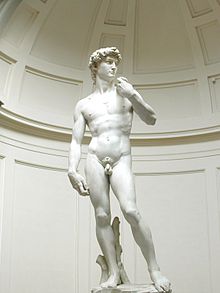
Although the Renaissance began at different times around Europe (some areas created art longer in the Gothic style than other areas) the transition from Gothic to Renaissance in Italy was signalled by a trend toward naturalism with a nod to classical sculpture. One of the most important sculptors in the classical revival was Donatello. The greatest achievement of what art historians refer to as his classic period is the bronze statue entitled David (not to be confused with Michelangelo's David), which is currently located at the Bargello in Florence. At the time of its creation, it was the first free-standing nude statue since ancient times. Conceived fully in the round and independent of any architectural surroundings, it is generally considered to be the first major work of Renaissance sculpture.
During the High Renaissance, the time from about 1500 to 1520, Michelangelo was an active sculptor with works such as David and the Pietà, as well as the Doni Virgin, Bacchus, Moses, Rachel, Orgetorix, and members of the Medici family. Michelangelo's David is possibly the most famous sculpture in the world, which was unveiled on September 8, 1504. It is an example of the contrapposto style of posing the human figure, which again borrows from classical sculpture. Michelangelo's statue of David differs from previous representations of the subject in that David is depicted before his battle with Goliath and not after the giant's defeat. Instead of being shown victorious over a foe much larger than he, David looks tense and battle ready.
Mannerist

During the Mannerist period, more abstract representations were praised, giving more thought to color and composition rather than realistic portrayal of the subjects in the piece. This is exemplified in Giambologna's Abduction/Rape of the Sabine Women, where the figures are not positioned in a way which is at all comfortable, or even humanly possible, but the position and emotion still come across. Another exemplar of the form is Benvenuto Cellini's 1540 salt cellar of gold and ebony, featuring Neptune and Amphitrite (earth and water) in elongated form and uncomfortable positions.
Baroque

In Baroque sculpture, groups of figures assumed new importance, and there was a dynamic movement and energy of human forms— they spiralled around an empty central vortex, or reached outwards into the surrounding space. For the first time, Baroque sculpture often had multiple ideal viewing angles. The characteristic Baroque sculpture added extra-sculptural elements, for example, concealed lighting, or water fountains. Often, Baroque artists fused sculpture and architecture seeking to create a transformative experience for the viewer. Gian Lorenzo Bernini was undoubtedly the most important sculptor of the Baroque period. His first works were inspired by Hellenistic sculpture of ancient Greece and imperial Rome. One of his most famous works is Ecstasy of St Theresa
Neo-Classical
The sculpture examples they actually embraced were more likely to be Roman copies of Hellenistic sculptures. In sculpture, the most familiar representatives are the Italian Antonio Canova, the Englishman John Flaxman and the Dane Bertel Thorvaldsen. The European neoclassical manner also took hold in the United States, where its high tide occurred somewhat later and is exemplified in the sculptures of William Henry Rinehart (1825-1874).
Modern Classicism
Modern Classicism contrasted in many ways with the classical sculpture of the 19th century which was characterized by commitments to naturalism (Antoine-Louis Barye) -- the melodramatic (François Rude) sentimentality (Jean Baptiste Carpeaux)-- or a kind of stately grandiosity (Lord Leighton) Several different directions in the classical tradition were taken as the century turned, but the study of the live model and the post-Renaissance tradition was still fundamental to them.
Auguste Rodin was the most renowned European sculptor of the early 20th century. He might be considered as sui generis -- that is, if anyone successfully composed in his turbulent, virtuosic style, they have yet to be discovered. But he is often considered a sculptural Impressionist, as are Medardo Rosso, Count Troubetski, and Rik Wouters, attempting to frame the charm of a fleeting moment of daily life.

Modern Classicism showed a lesser interest in naturalism and a greater interest in formal stylization. Greater attention was paid to the rhythms of volumes and spaces - as well as greater attention to the contrasting qualities of surface (open, closed, planar, broken etc) while less attention was paid to story-telling and convincing details of anatomy or costume. Greater attention was given to psychological realism than to physical realism. Greater attention was given to showing what was eternal and public, rather than what was momentary and private. Greater attention was given to examples of ancient and Medieval sacred arts:Egyptian, Middle Eastern, Asian, African, and Meso-American. Grandiosity was still a concern, but in a broader, more world-wide context.

Early masters of modern classicism included: Aristide Maillol, Alexander Matveev, Joseph Bernard, Antoine Bourdelle, Georg Kolbe, Libero Andreotti, Gustav Vigeland, Jan Stursa, Constantin Brancusi.
As the century progressed, modern classicism was adopted as the national style of the two great European totalitarian empires: Nazi Germany and Soviet Russia, who co-opted the work of early masters, like Kolbe and Arno Breker in Germany, and Matveev in Russia. Nazi Germany had a 15-year run; but over the 70 years of the USSR, new generations of sculptors were trained and chosen within their system, and a distinct style, socialist realism, developed, that returned to the 19th century's emphasis on melodrama and naturalism.
Classical training was rooted out of art education in Western Europe (and the Americas) by 1970 and the classical variants of the 20th century were marginalized in the history of modernism. But classicism continued as the foundation of art education in the Soviet academies until 1990, providing a foundation for expressive figurative art throughout eastern Europe and parts of the Middle East. By the year 2000, the European classical tradition maintains a wide appeal to viewers - especially tourists - and especially for the ancient, Renaissance, Baroque, and 19th century periods -- but awaits an educational tradition to revive its contemporary development.
In the rest of Europe, the modern classical became either more decorative/art deco (Paul Manship, Carl Milles) or more abstractly stylized or more expressive (and Gothic) (Anton Hanak, Wilhelm Lehmbruck, Ernst Barlach, Arturo Martini) -- or turned more to the Renaissance (Giacomo Manzu, Venanzo Crocetti) or stayed the same (Charles Despiau, Marcel Gimond).
Modernism

In the early days of the 20th century Pablo Picasso revolutionized the art of sculpture when he began creating his constructions fashioned by combining disparate objects and materials into one constructed piece of sculpture, - by addition. Picasso reinvented the art of sculpture with his innovative use of constructing a work in three dimensions with disparate material. Just as collage was a radical development in two dimensional art; so was construction a radical development in three dimensional sculpture.
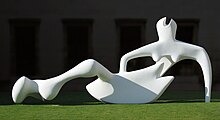
In Europe, by the 1930s and 1940s Modernism in sculpture became more abstract and stylized, exemplified by Picasso, Gaston Lachaise, Sir Jacob Epstein, Henry Moore, Alberto Giacometti, Joan Miró, Julio González and Jacques Lipschitz,. Eventually artists like Isamu Noguchi, David Smith, Alexander Calder, Richard Lippold, George Rickey Louise Bourgeois and Louise Nevelson came to characterize the look of modern sculpture. By the 1960s Abstract expressionism, Geometric abstraction and Minimalism as exemplified by the Cubi's of David Smith, and the welded steel work of Sir Anthony Caro, the large scale work of John Chamberlain, and Mark di Suvero, and the Minimalist works by Tony Smith, Robert Morris, Donald Judd, Richard Serra, Dan Flavin and others led contemporary abstract sculpture in new directions.
Since the 1950s Modernist trends in sculpture both abstract and figurative have dominated the public imagination and the popularity of Modernist sculpture has all but eliminated the traditional approach. During the 1960s figurative sculpture by artists as stylized as Leonard Baskin, Ernest Trova and Marisol Escobar became popular, and by the 1980s the painter Fernando Botero emerged with monumental figures reminiscent of the fat characters in his paintings.
Also during the 1960s artists as diverse as Claes Oldenburg, George Segal, Edward Kienholz, Duane Hanson, and John DeAndrea explored imagery and figuration through installation art in new ways.
Modernist sculpture movements include Geometric abstraction, De Stijl, Suprematism, Constructivism, Dadaism, Cubism, Surrealism, Futurism, Minimalism, Formalism Abstract expressionism, Pop-Art, and Installation art among others.
Post-modernism
Post-modern sculpture occupies a broader field of activities than Modernist sculpture, as Rosalind Krauss has observed. Her idea of sculpture in the expanded field identified a series of oppositions that describe the various sculpture-like activities that are post-modern sculpture:
- Site-Construction is the intersection of landscape and architecture
- Axiomatic Structures is the combination of architecture and not-architecture
- Marked sites is the combination of landscape and not-landscape
- Sculpture is the intersection of not-landscape and not-architecture
Krauss' concern was creating a theoretical explanation that could adequately fit the developments of Land art, Minimalist sculpture, and Site-specific art into the category of sculpture. To do this, her explanation created a series of oppositions around the work's relationship to its environment.
This section needs expansion. You can help by adding to it. |
Gallery of sculpture
-
Gaston Lachaise, Floating Figure 1927, bronze, no. 5 from an edition of 7, National Gallery of Australia
-
Julio González, Monsieur Cactus, 1939
-
Isamu Noguchi, Cronos, 1947 (cast 1963)
-
Alberto Giacometti, Three Men Walking II, 1949 Metropolitan Museum of Art
-
Louise Bourgeois, Quarantania I, bronze, 1947-53, Museum of Fine Arts, Houston
-
David Smith, Tanktotem 2, 1952-1953
-
Henry Moore, Three Piece Reclining figure No.1, 1961, Yorkshire
-
Alexander Calder, The Crab, painted steel, 1962, Museum of Fine Arts, Houston
-
Tony Smith, Free Ride, 1962, 6'8 x 6'8 x 6'8 (the height of a standard US door opening)
-
Pablo Picasso, Public Sculpture, 1967, Chicago, Illinois
-
James Rosati, Untitled (Three Forms), stainless steel, 1975-1976, Honolulu Academy of Arts
-
Sir Anthony Caro, Black Cover Flat, 1974, steel, Tel Aviv Museum of Art
-
Louise Nevelson, Transparent Horizon, 1975
-
Joan Miró, Woman and Bird, 1982, Barcelona, Spain
-
Richard Serra, Fulcrum 1987, 55 ft high free standing sculpture of Cor-ten steel near Liverpool Street station, London
-
Mark di Suvero, Aurora 1992-1993, National Gallery of Art Sculpture Garden
Contemporary genres
Some modern sculpture forms are now practiced outdoors, and often in full view of spectators, thus giving them kinship to performance art in the eyes of some. Ice sculpture is a form of sculpture that uses ice as the raw material. It's popular in China, Japan, Canada, Sweden, and Russia. Ice sculptures feature decoratively in some cuisines, especially in Asia. Kinetic sculptures are sculptures that are designed to move, which include Mobiles. Snow sculptures are usually carved out of a single block of snow about 6 to 15 feet (4.6 m) on each side and weighing about 20 - 30 tons. The snow is densely packed into a form after having been produced by artificial means or collected from the ground after a snowfall. Sound sculptures take the form of indoor sound installations, outdoor installations such as aeolian harps, automatons, or be more or less near conventional musical instruments. Sound sculpture is often site-specific. A Sand castle can be regarded as a sand sculpture. Weightless Sculpture (in outer space) as a concept is created in 1985 by the Dutch artist Martin Sjardijn. LEGO brick sculpting involves the use of common LEGO bricks to build realistic or artistic sculptures sometimes using hundreds of thousands of bricks.
Social status
Worldwide, sculptors are usually tradesmen whose work is unsigned. But in the Classical tradition, some sculptors began to receive individual recognition in Periclean Athens and more so in the Renaissance revival 2000 years later, culminating in the career of Michelangelo who entered the circle of princes. Sculpture was still a trade, but exceptional sculptors were recognized on a level with exceptional poets and painters. In the 19th century, sculpture also became a bourgeois/upper class avocation, as poetry and painting had been, and the classical work of women sculptors began to appear.

Similar arts
Other arts which can be regarded as sculptures include:
- Costume
- Doll
- Floral design (Ikebana)
- Glassblowing
- Hologram
- Mask
- Pottery
- Sugar sculpture
- Light sculpture
- Pumpkin carving
- Tactile sculpture
- Dynamic textures
- Origami
References
- ^ Castedo, Leopoldo, A History of Latin American Art and architecture, Frederick A. Praeger, Publisher, New York, 1969
See also
- List of basic sculpture topics
- Bronze sculpture
- Equestrian sculpture
- History of sculpture
- List of sculptors
- Depictions of nudity
- Marble sculpture
- Stone carving
- Stone sculpture
- Stonemasonry
- Glassblowing
- Environmental sculpture
- LEGO brick sculpture
- Petroglyph
External links
- Essays on sculpture from Sweet Briar College, Department of Art History
- International Sculpture Center
- Sculpture artists listings from the-artists.org
- Escultores.com Videos and pictures of sculpture










